The Ultimate Herb & Citrus Compound Butter for Turkey: Achieve a Perfectly Golden, Juicy, and Flavorful Holiday Roast
Transform your Thanksgiving turkey from ordinary to extraordinary with a luscious, aromatic herb and citrus compound butter. This culinary secret weapon is designed to infuse your turkey with incredible flavor, guarantee a moist and tender interior, and deliver that coveted, irresistibly crispy, golden-brown skin. Forget dry, bland poultry; this easy-to-make flavored butter combines softened unsalted butter with fresh herbs, bright citrus zest, and pungent garlic, creating a flavor bomb that melts into every crevice of your bird as it roasts. Prepare it in minutes, ahead of time, and simply apply it before roasting for a stress-free holiday meal that will impress everyone at your table. This simple yet profound recipe promises a Thanksgiving turkey that is truly unforgettable.
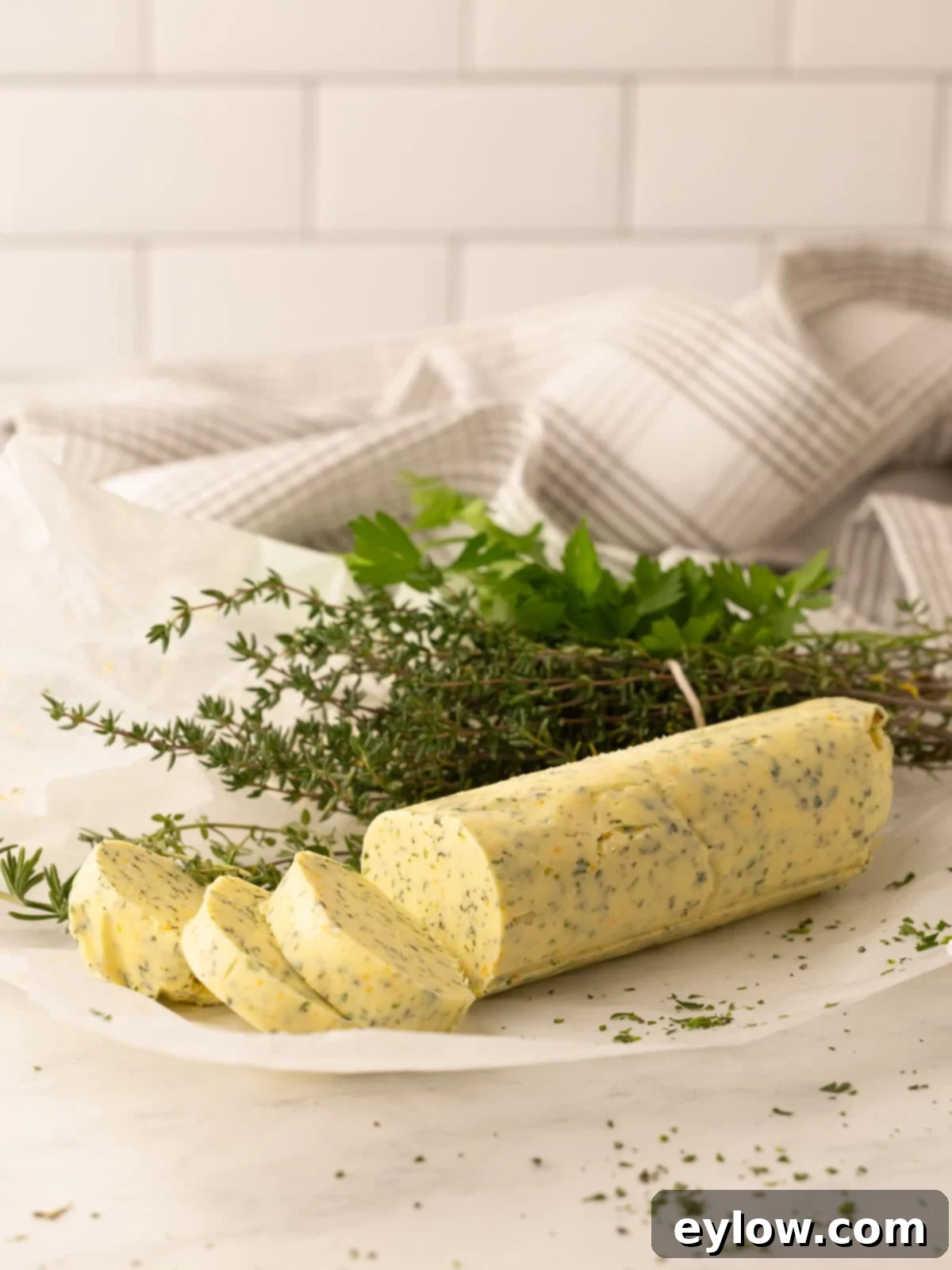
For countless holiday seasons, I’ve relied on the magic of an herbed compound butter to elevate my turkey to new heights. The secret to that beautiful, golden, crispy skin lies in the rich fat content of the butter, which renders beautifully during roasting. Beyond the visual appeal, this special butter deeply infuses the turkey meat with savory and aromatic notes, ensuring every bite is juicy and packed with flavor. The result? A stunning centerpiece that elicits gasps of “ooo’s” and “ahhh’s” as you pull it from the oven. It sounds like a gourmet chef’s trick, but I promise, it’s incredibly simple to prepare and will make your Thanksgiving dinner the highlight of the year.
Why You’ll Love This Compound Butter Recipe
This compound butter isn’t just a recipe; it’s a game-changer for your holiday cooking. Here’s why it will become your go-to method for roasting poultry:
- Effortlessly Simple: Despite its impressive results, this recipe is incredibly easy to make, requiring minimal prep time and basic ingredients. You don’t need advanced culinary skills to achieve professional-level flavor.
- Convenient Make-Ahead Option: One of the biggest advantages is its versatility for meal prep. You can whip up a batch of this compound butter days or even weeks in advance, then refrigerate or freeze it. This frees up valuable time on a busy holiday cooking day, allowing you to focus on other dishes or simply relax.
- Unbeatable Flavor Infusion: The blend of fresh herbs, zesty citrus, and pungent garlic permeates the turkey meat as it cooks, creating a depth of flavor that traditional basting simply can’t achieve. The butter literally melts into the meat, carrying these wonderful aromatics directly where they’re needed most.
- Superior Moisture and Tenderness: The fat from the butter bastes the turkey from the inside out and under the skin, preventing it from drying out. This ensures every slice of turkey, from breast to thigh, remains incredibly juicy and tender.
- Achieve Golden, Crispy Skin: The butter’s fat content contributes to a perfectly golden-brown, irresistibly crispy skin, adding a delightful textural contrast to the tender meat. Say goodbye to pale, rubbery turkey skin!
- Customizable Seasoning: You have complete control over the salt and pepper content. Whether your turkey is already brined or you prefer to season it separately, you can adjust the butter to suit your taste and dietary needs.
Beyond turkey, consider adding a thin slice of this flavorful compound butter to individual roast bone-in chicken breasts as they finish baking in the oven for an instant flavor boost and added moisture. It’s truly a versatile ingredient!
Essential Ingredients for Herb & Citrus Compound Butter

Crafting the perfect compound butter starts with selecting high-quality, fresh ingredients. Here’s a breakdown of what you’ll need and why each component is crucial:
- Butter: The foundation of our compound butter. I highly recommend using unsalted butter. This gives you precise control over the overall saltiness of your dish, especially if you’ve already dry brined your turkey (which I highly recommend for the best flavor!). If your turkey isn’t brined, you can still use unsalted butter and season the bird thoroughly with salt first, then apply the compound butter. If you opt for salted butter, be sure to significantly reduce or omit any additional salt added to the turkey itself to avoid over-salting. Quality butter makes a noticeable difference in flavor and texture.
- Garlic: Fresh garlic cloves are non-negotiable for that vibrant, pungent flavor that complements poultry so well. Minced garlic, or even better, garlic zested on a microplane or smeared into a paste, ensures that the garlic flavor is evenly distributed without any harsh raw chunks.
- Fresh Herbs: The soul of this compound butter. A classic blend for turkey often includes fresh thyme, fresh parsley, and rosemary. However, feel free to experiment with other complementary herbs like sage (a Thanksgiving staple!), chives for a delicate oniony note, or marjoram for a slightly sweeter, piney aroma. You don’t need every herb on this list; choose your favorite combination of two to three for a balanced and aromatic profile. Always opt for fresh herbs over dried for superior flavor.
- Citrus Zest: This is my favorite secret ingredient for brightening and lifting the overall flavor of the turkey. Lemon zest is a popular choice, adding a beautiful, fragrant acidity that cuts through the richness of the butter. Orange zest is another fantastic option, offering a slightly sweeter, more autumnal aroma. You can use one or both! The zest, not the juice, is where all the aromatic oils are concentrated, providing a fresh, vibrant essence without adding excess liquid that could make the butter watery.
You’ll find precise measurements for these ingredients, along with optional salt and black pepper, in the detailed recipe card below. Remember, the salt and pepper are truly optional, especially if you’re brining your turkey.
For the absolute best, most flavorful, and moist turkey imaginable, I cannot stress this enough: brine your turkey first! If you’ve never tried it, don’t be intimidated. My turkey dry brine tutorial offers a super easy, mess-free method that is significantly simpler than wet brining and yields an incredibly flavorful bird. Combine dry brining with this compound butter, and you’ll have a show-stopping turkey every time.
Chef’s Note: What is a Compound Butter? A compound butter, also known as an infused butter or flavored butter, is essentially softened butter that has been blended with various flavorings. These can include fresh herbs, aromatic spices, bright citrus zest, savory garlic, sweet honey, or even robust cheeses. The beauty of compound butter lies in its versatility and ease of use. It’s a fantastic way to introduce concentrated flavor into your dishes. They can be savory, like this herb and citrus blend perfect for turkey, or sweet, such as a delightful maple vanilla butter that’s wonderful on pancakes or toast. There are also gourmet variations like sophisticated blue cheese butter, earthy truffle butter, or this unique miso butter, which adds an incredible umami depth to fish and seafood. Once prepared, compound butters can be shaped into logs, chilled, and sliced as needed, making them a convenient and elegant addition to any kitchen.
Substitutions and Creative Variations
One of the joys of cooking with compound butter is its adaptability. Feel free to customize this recipe to your preferences or what you have on hand:
- Herb & Citrus Combinations: Don’t be afraid to experiment! Vary the types of fresh herbs you use, or even omit the citrus if you prefer a purely savory herb butter. Consider a blend of sage and thyme for a more traditional Thanksgiving flavor, or rosemary and chives for a sharper, more peppery note.
- Garlic Alternatives: If fresh garlic isn’t available or you’re short on time, you can substitute it with garlic powder. A good rule of thumb is to use about ¼ teaspoon of garlic powder for every fresh garlic clove specified in the recipe. Just be sure to blend it thoroughly.
- Unique Flavor Profiles: Get creative with distinct flavor combinations. Try a vibrant lemon, parsley, and dill butter, which is fantastic not only on turkey but also on fish. For a Southwestern twist, incorporate spices like cumin, coriander, chili powder, and either sweet or smoked paprika into your butter.
- Using Dried Herbs: While fresh herbs are always preferred for their vibrant flavor and aroma, dried herbs can be used in a pinch. If substituting dried for fresh, use approximately half the amount of dried herbs specified for fresh. When making compound butter with dried herbs, it’s crucial to allow the butter to sit for at least an hour (or longer) before using. This gives the dried herbs time to rehydrate and soften, releasing their full flavor into the butter.
- Adding a Touch of Heat: For those who enjoy a little kick, a pinch of red pepper flakes or a tiny amount of finely minced fresh chili can add a wonderful warmth to your compound butter.
- Sweet & Savory Notes: A small amount of finely grated onion or shallot can add another layer of savory depth. For a hint of sweetness that balances the savory, consider a tiny dash of honey or maple syrup, especially if using orange zest.
A simple slice of this versatile butter can also beautifully dress up blanched green beans, turning a quick 5-minute side dish into something truly special.
Chef’s Tip on Using Fresh Herbs: For the best results and ease of chopping, ensure your fresh herbs are completely dry before you start. Wet herbs tend to clump together and are difficult to mince finely. Wash your herbs well in advance, then spread them out on a clean kitchen towel or paper towels on your counter. Allow them to air dry fully before chopping. This simple step ensures a clean, even chop and better incorporation into your butter.
Step-by-Step Guide: Crafting Your Herb & Citrus Compound Butter
Making compound butter is a straightforward process, but a few key techniques will ensure a smooth, well-blended, and perfectly flavored result. Follow these steps for success:
First and foremost, start with very soft butter at room temperature. This is crucial for easy mixing and ensuring all ingredients are evenly incorporated. Avoid melting the butter, as this will change its emulsion and texture. Typically, 2-3 hours on the counter is enough to soften butter sufficiently. Before you begin, gather a piece of parchment paper, waxed paper, or even plastic wrap to form your butter log. Do not use aluminum foil, as it can react with acidic ingredients (like citrus zest) and is prone to tearing.

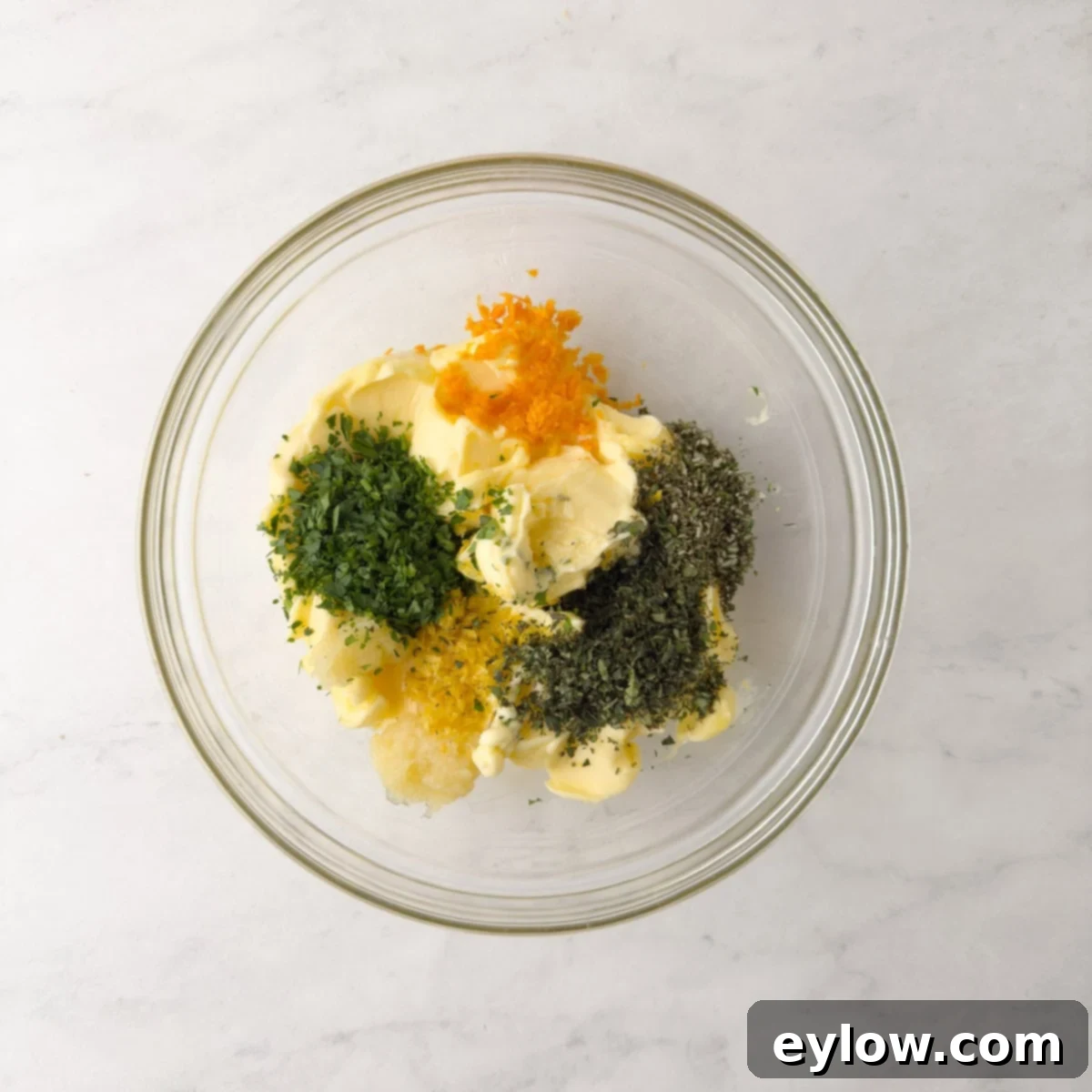
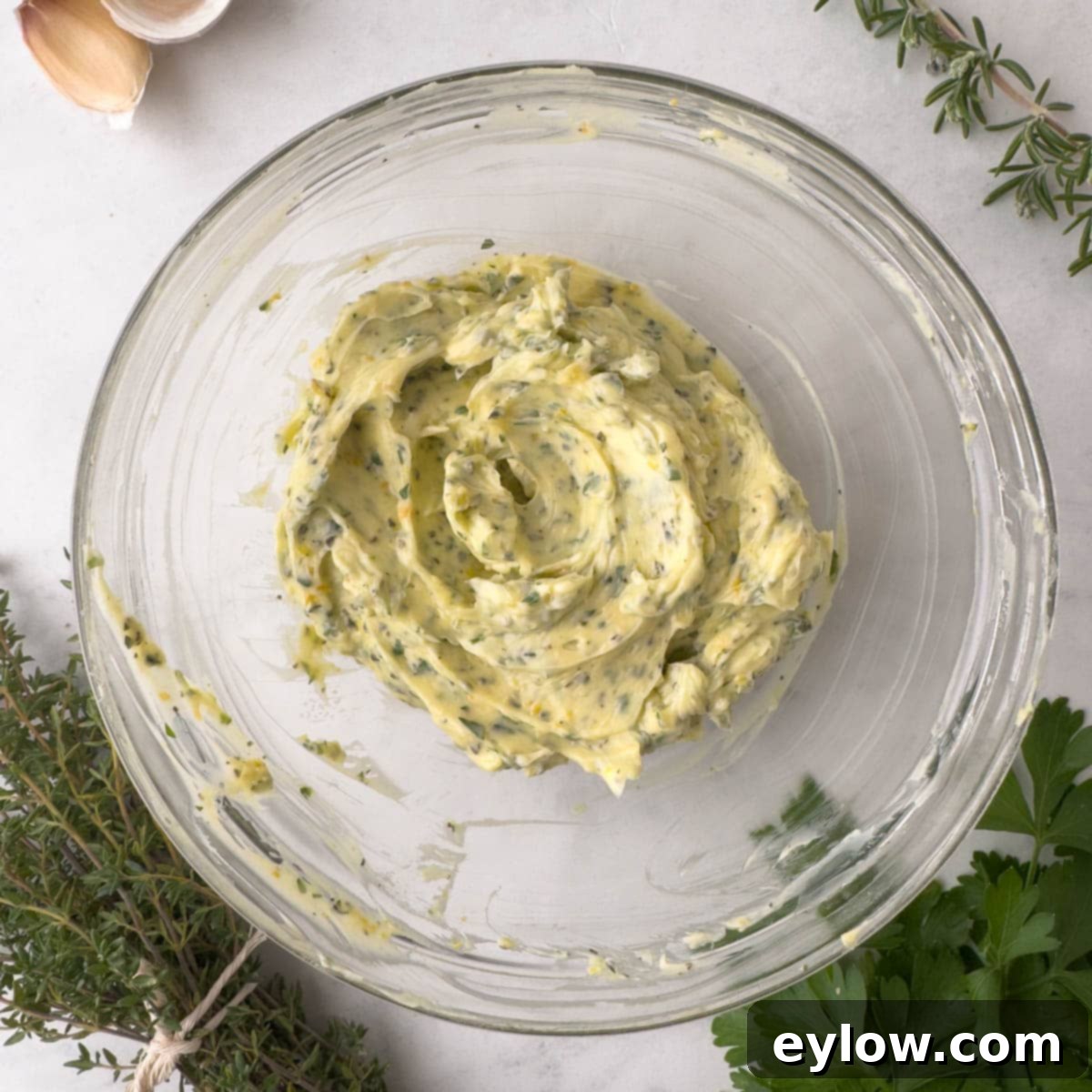
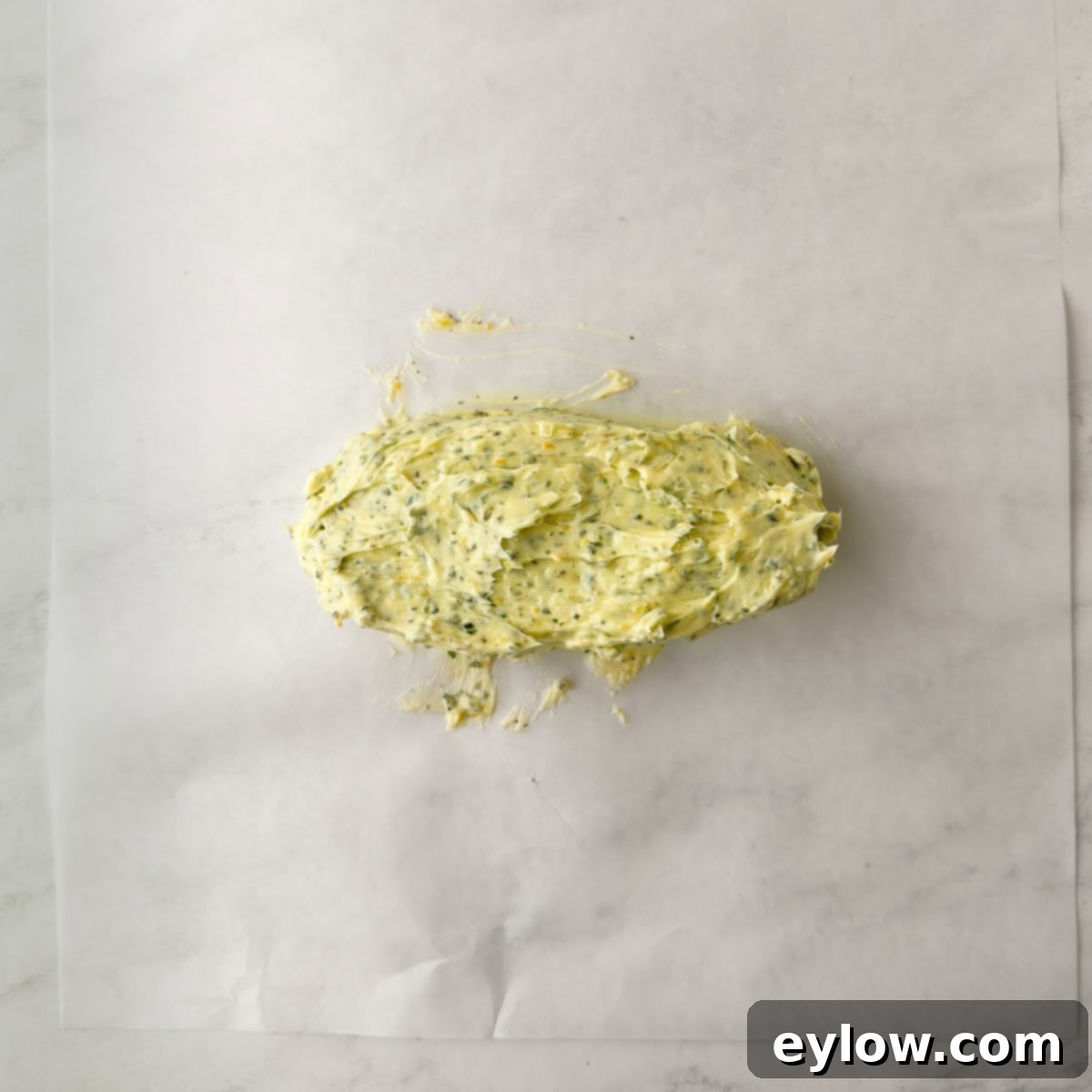
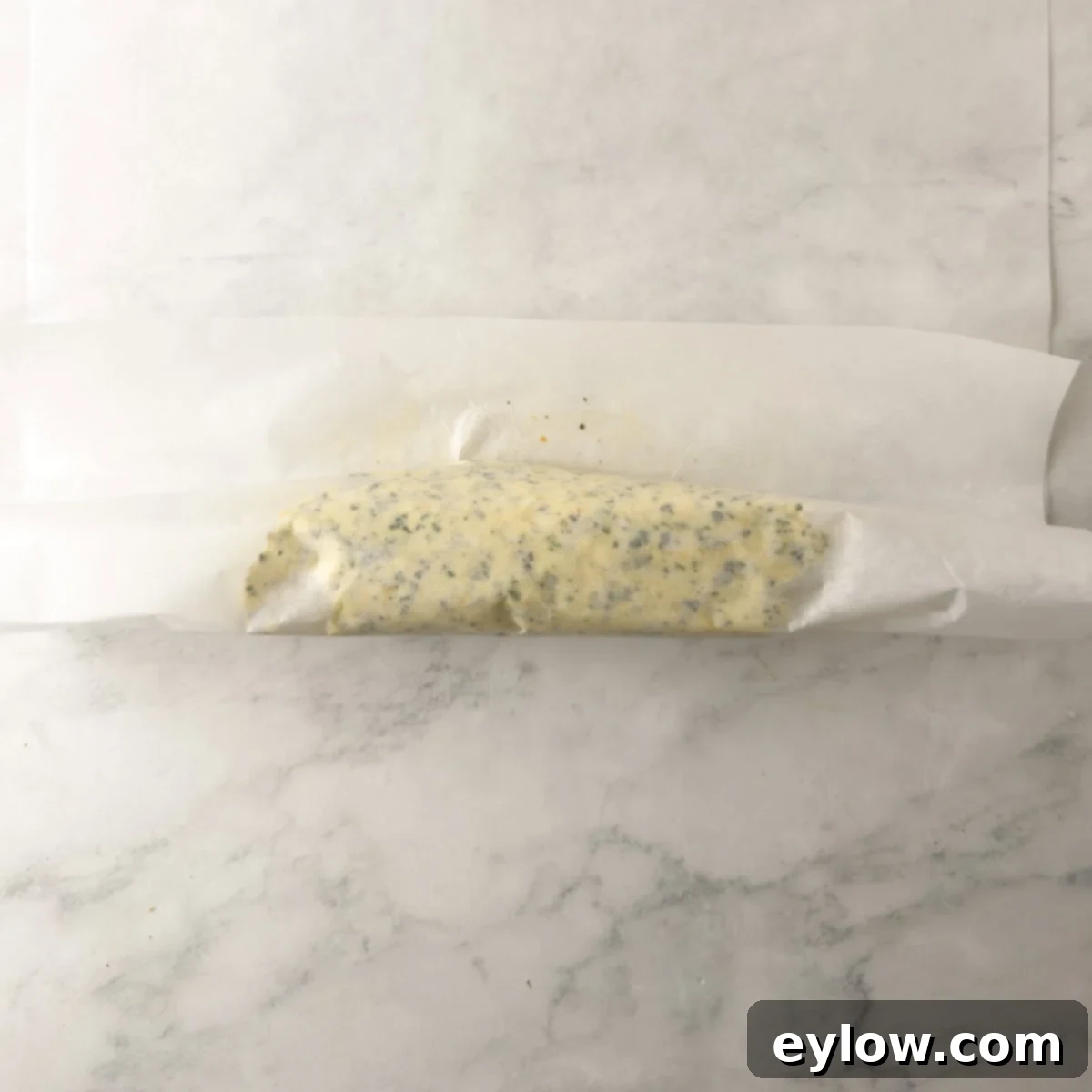

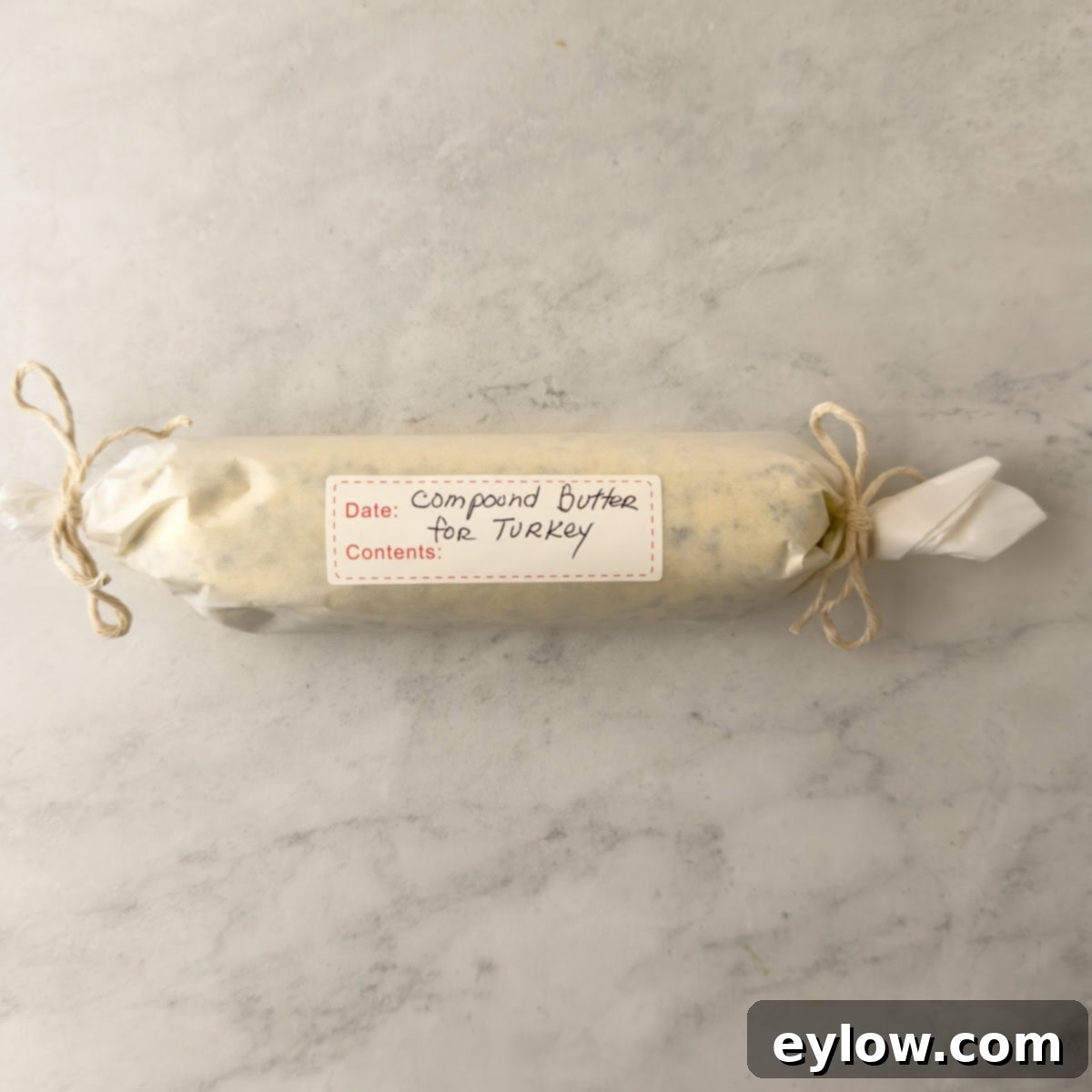
Chef’s Tip: How to Achieve Very Fine Garlic. Nothing is worse than biting into a harsh piece of raw garlic in your perfectly flavored butter. To ensure your garlic is seamlessly incorporated and potent without being overwhelming, avoid simply rough chopping it. Instead, employ one of these techniques:
- Use a microplane zester: This is my preferred method. Zest the garlic directly into the softened butter for a super fine, almost paste-like consistency that melts into the butter beautifully.
- Chop and smear into a paste: Finely chop the garlic as much as possible, then use the flat side of your chef’s knife to smear and press the chopped garlic against your cutting board, creating a smooth paste.
- Use a garlic press: Press the garlic, then give it another quick chop by hand to ensure no large pieces remain.
Any of these methods will result in a fine garlic paste that effortlessly blends into your butter, delivering exquisite flavor without any unwelcome chunky surprises.
Mastering the Application: How to Use Compound Butter on Your Turkey
Proper application of compound butter is key to maximizing its benefits. Follow these steps to ensure a perfectly flavored, moist, and golden turkey:
As a general rule, it’s beneficial to allow your turkey to come closer to room temperature before roasting. Remove the turkey from the refrigerator and let it stand unwrapped on the counter for at least one hour (or up to two hours for very large birds) to take the chill off. This promotes more even cooking. Once the turkey is ready, ensure your compound butter is at room temperature too; this makes it much easier to spread. This method works beautifully whether you’re roasting a whole turkey or just a turkey breast.
Applying the Compound Butter:
- Loosen the Skin: The goal is to get as much butter as possible directly onto the meat, underneath the skin. With clean, slightly dampened hands, gently work your fingers between the turkey skin and the breast meat, starting at the cavity opening. Slowly and carefully create pockets under the skin, extending your fingers as far back under the breast skin and down towards the legs as possible. Be gentle but firm; the skin is quite elastic, but you want to avoid tearing it.
- Spread Under the Skin: Once the skin is sufficiently loosened, take small amounts of the softened compound butter and spread it directly onto the breast meat and upper thigh meat, underneath the skin. Aim for an even layer across these key areas. This butter will melt and baste the meat from the inside, ensuring maximum moisture and flavor.
- Apply On Top of the Skin: Next, take a little more compound butter and rub it generously over the entire exterior of the turkey, including the breast, legs, and wings. This layer will help achieve that coveted golden, crispy skin.
- Flavor the Cavity: For an extra layer of flavor, take a small amount of butter and rub it onto the inside walls of the turkey cavity. You can also place an onion, some extra herbs, or a halved lemon inside the cavity for added aroma during roasting.
The exact amount of compound butter you use will depend on the size of your turkey. You won’t necessarily use the entire batch (which is great, as you can save the extra!). Be generous but avoid over-doing it; a delicious, golden roast turkey is the aim. Once the butter is applied, your turkey is ready for roasting according to your preferred method and temperature. The flavors will melt into the bird, creating a self-basting effect that ensures a succulent and aromatic result.
Beyond the Turkey: Versatile Serving Suggestions
While this compound butter is perfectly crafted for your holiday turkey, its incredible flavor profile makes it a highly versatile addition to countless other dishes. Don’t let any leftover butter go to waste!
- Elevate Other Proteins: It’s absolutely wonderful on roast chicken, adding the same moisture and herbaceous flavor. Try a slice on a perfectly grilled steak, allowing it to melt and create a rich, savory sauce. It’s equally delicious on grilled or baked fish, enhancing delicate flavors without overpowering them.
- Transform Potatoes: Swirl a generous spoonful into creamy riced mashed potatoes or decadent whipped sweet potatoes for an instant flavor upgrade. The herbs and citrus cut through the richness beautifully.
- Brighten Vegetables: Add a dollop to simple steamed, roasted, or blanched vegetables like asparagus, green beans, or carrots to dramatically elevate their flavor. It’s an effortless way to make everyday sides feel gourmet.
- Perfect for Breads: Use it to butter warm dinner rolls, slices of crusty bread, or even garlic bread. It creates a savory, aromatic spread that’s far superior to plain butter. Spread it on toasted baguette slices for a quick appetizer.
- Summer BBQ Star: In the warmer months, it’s absolutely terrific on grilled corn on the cob, melting into the kernels for a burst of fresh flavor.
- Southern Comfort: Smear it on a warm slice of naturally gluten-free cornbread for a delightful sweet and savory treat.
For the best flavor and spreadability when using chilled or frozen compound butter, always allow it to soften at room temperature for about 15-30 minutes before serving. This ensures the full aroma and texture can be appreciated.
Storage Solutions: Keeping Your Compound Butter Fresh
One of the many advantages of making compound butter is its excellent shelf life, allowing you to prepare it well in advance and have it ready whenever inspiration strikes.
When stored properly, your homemade compound butter will last 1 to 2 weeks in the refrigerator. To maintain its freshness and prevent it from absorbing any unwanted odors from your refrigerator, ensure it is tightly rolled and wrapped in parchment paper, then ideally further wrapped in plastic film or stored in an airtight container. This double layer of protection is key to preserving its vibrant flavors.
For longer-term storage, compound butter freezes beautifully. You can freeze it for up to 3 months. Once frozen solid, you can simply slice off just the amount you need for a recipe, then rewrap the remaining log and return it to the freezer. This makes it incredibly convenient for impromptu meals or future holiday preparations.
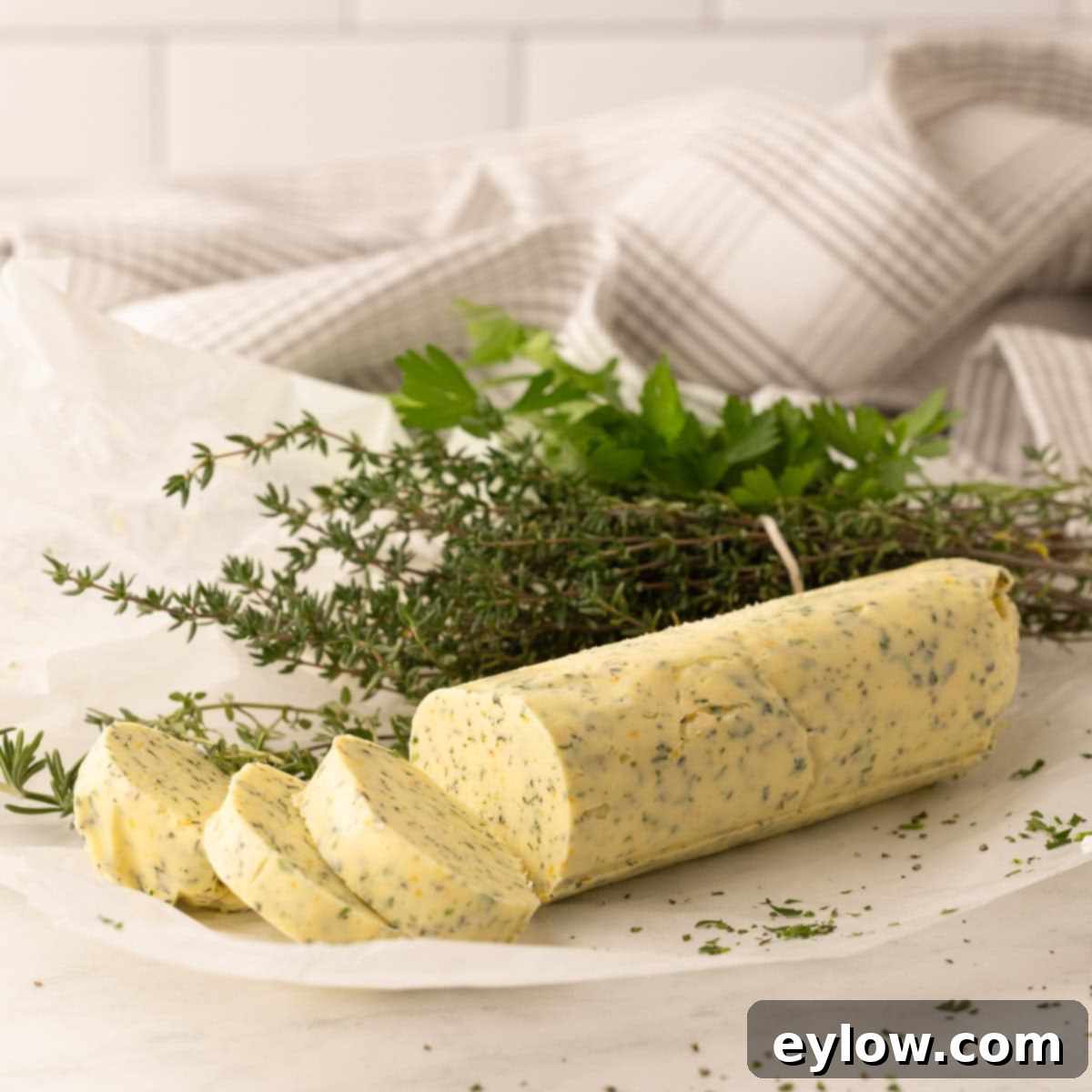
Frequently Asked Questions About Compound Butter for Turkey
Yes, you absolutely can use salted butter in this recipe. However, it’s crucial to be mindful of the overall salt content in your dish. If your turkey is already brined (which often adds a good amount of salt), or if you plan to season the turkey heavily elsewhere, you should reduce or omit any additional salt in the compound butter or on the bird itself. Taste as you go, and always err on the side of caution with salt, as you can always add more later.
One of the greatest benefits of using compound butter, particularly when applied under the skin of the breast meat and over the top before roasting, is that it creates a natural self-basting effect. As the butter melts, it continuously lubricates the meat and skin, keeping it moist and promoting browning. This significantly reduces or even eliminates the need for traditional basting during cooking, saving you time and effort and reducing the need to open the oven frequently, which can lower the oven temperature.
Yes, plant-based or dairy-free butters can be a good substitute for traditional dairy butter in this recipe, making it suitable for those with dietary restrictions. For best results, choose a stick-form vegan butter rather than a whipped or soft-tub variety, as these tend to have a firmer consistency and melt more predictably, similar to real butter. Ensure the dairy-free butter is softened to room temperature before blending in the herbs and aromatics, just as you would with regular butter.
This compound butter is perfect for make-ahead convenience. You can prepare it up to 1-2 weeks in advance and store it tightly wrapped in the refrigerator. For longer storage, it can be frozen for up to 3 months. This is ideal for holiday planning, allowing you to tackle one less task on the big cooking day.
Achieving crispy turkey skin involves a few factors. First, drying the turkey thoroughly before applying the butter is crucial. Pat the skin completely dry with paper towels. Second, applying a generous layer of this compound butter under and over the skin provides the fat needed for rendering and browning. Finally, roasting at a sufficiently high temperature, at least for part of the cooking process, helps render the fat and crisp the skin. Avoid covering the turkey too early, as this can trap steam and prevent crisping.
More Recipes Enhanced by Compound Butter
This savory herb and citrus compound butter is incredibly versatile and can be used in numerous dishes beyond just turkey, adding a burst of fresh flavor to everyday meals. Its ability to melt beautifully and infuse ingredients makes it a culinary staple:
- Potatoes: Stir it into creamy mashed potatoes or roasted potato wedges for an elevated side dish.
- Chicken: Place a sliver under the skin or on top of chicken breasts before oven roasting, or use it to flavor a whole roast chicken for a deeply satisfying meal.
- Vegetables: Toss simple steamed or blanched vegetables like broccoli, carrots, or green beans with a knob of melted compound butter for an instant flavor boost.
- Fish and Seafood: Melt it over pan-seared scallops, grilled salmon, or baked white fish for a quick, gourmet touch.
- Garlic Bread: Spread it on sliced baguette and toast for the most flavorful homemade garlic bread you’ve ever had.
- Steak: A pat of compound butter on a hot grilled or pan-seared steak creates a luscious, herbaceous sauce as it melts.
The possibilities are truly endless, making this a fantastic staple to keep on hand in your refrigerator or freezer.
- How to Make Creamy Riced Mashed Potatoes
- Roast Split Chicken Breast
- How to Roast a Whole Chicken (sear first method)
Did You Make This Recipe?
If you tried this incredible herb and citrus compound butter for your turkey or any other dish, I would absolutely love to hear from you! Your feedback is invaluable, and I truly enjoy hearing about your cooking experiences. Please take a moment to add your comment below and share how it turned out. If you loved the results and enjoyed the flavor it brought to your meal, please consider giving it a 5-star rating! Your ratings and reviews are incredibly helpful to other readers and inspire more delicious recipes.
📖 Recipe

Herb & Citrus Compound Butter for Turkey
Sally Cameron
Pin Recipe
Ingredients
- 8 ounces unsalted butter (2 sticks, half pound, softened to room temperature. See notes for salted butter.)
- 2 teaspoons finely chopped fresh thyme leaves
- 2 teaspoons finely chopped fresh Italian parsley leaves
- 1 teaspoon finely chopped fresh rosemary leaves
- 2 large fresh garlic cloves (zested with a microplane or chopped fine and smeared into a paste)
- 1 teaspoon lemon zest (optional, from 1 medium lemon)
- 1 teaspoon orange zest (optional, from 1 medium orange)
- ½ teaspoon Kosher salt (optional, or to taste)
- ¼ teaspoon black pepper (optional, freshly ground)
Instructions
-
Soften the Butter: Ensure your butter is very soft, at room temperature, before you begin blending. This typically takes 2-3 hours at room temperature. It should be easily spreadable but not melted or greasy. If you try to speed up the process by microwaving, be very careful not to melt it, as this will affect the texture of the compound butter.
-
Prepare Aromatics: Finely chop all your selected fresh herbs. For the garlic, either zest it using a microplane for a super smooth paste-like consistency or chop it very finely, then use the back of your chef’s knife to smear it into a paste. This ensures the garlic blends seamlessly and doesn’t create harsh raw chunks. Finely chop citrus zests.
Combine Ingredients: Add the softened butter along with all the prepared herbs, garlic, and citrus zest (if using) into a medium mixing bowl. If you’re adding optional salt and pepper directly to the butter, include them now. Blend all ingredients thoroughly with a flexible spatula or a sturdy fork until everything is well mixed and the herbs and other aromatics are evenly distributed throughout the butter.
-
Form the Butter Log: Refer to the photos in the post above for visual guidance. To make a neat butter log, lay a full-size (approximately 12″x16″) piece of parchment paper or waxed paper on a clean work surface. Scoop the herbed butter onto the paper, placing it near the bottom third, and gently shape it into a rough log.
Roll and Secure: Fold the bottom edge of the paper up and over the butter. Then, using your fingers or the spatula, gently pull the top edge of the paper back against the butter to tighten it and form a compact log. Continue rolling the butter log the entire length of the parchment paper, ensuring it is tightly compressed. Once rolled, twist the ends of the parchment paper in opposite directions to further compress and seal the butter. You can tie the twisted ends with kitchen twine or rubber bands for extra security.
-
Chill and Store: Refrigerate the formed compound butter log until it is firm enough to slice, usually a few hours. This compound butter will last for 1-2 weeks in the refrigerator. For extended freshness, wrap the log in an additional layer of plastic film. For longer storage, freeze the butter for up to 3 months. When ready to use, simply slice off the desired amount and allow it to soften slightly before application.
Notes
Unsalted vs. Salted Butter: While unsalted butter gives you better control over the final seasoning, you can use salted butter. If you do, make sure to significantly reduce or omit any additional salt added to the turkey itself to prevent it from becoming too salty.
Parchment Paper: The parchment paper I use for this recipe is a non-stick variety, which makes rolling and unrolling the butter log effortless. You can find it here on Amazon.
